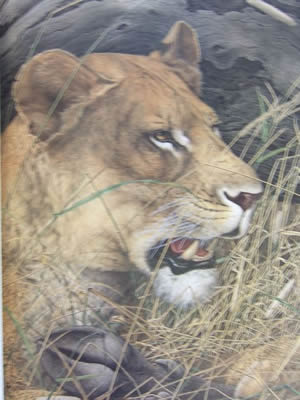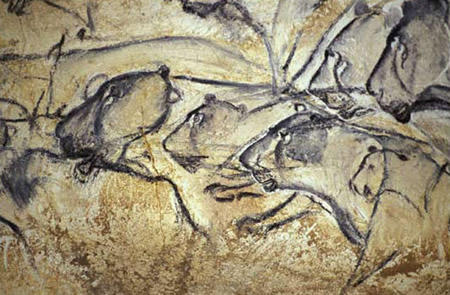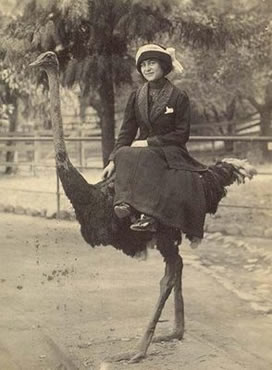Some Bird and Mammals of Africa by Hilary Hook, & Illustrated by Axel Amuchastegui

When embarking on some research for this article, my first port of call was my cousin Michael, who now lives in Rome, but was brought up, like myself, in the West Country not far from our family origins in Wiltshire. What I wanted to specifically find out was a) did our grandfather Leigh Heritage Richmond indeed own a Lion when living in Bath, as was popularly believed by all of us grandchildren, b) did he also ride Ostriches as a boy in South Africa and c) if either of these facts were true, how could I find out more? I wanted to see if he had any insights into our family's not so distant history in Africa and his response pretty much sums up our family and their somewhat loose grip on reality!

My father was the youngest of 4 siblings and, therefore, his parents were pretty old by the time I was born and sadly passed away before I was grown up enough to ask these questions myself. Michael, however, is a good 15 years older than me and so has no legitimate excuse for his ignorance of our shared heritage! Like so many of these family stories I have heard over the years, finding the truth behind the myth can be, at times, challenging, but there is always some concrete fact upon which the sometimes elaborate, often involved, and always theatrical tale has been based. But this last sentence of my cousin's perfectly summed up why this story was so intriguing to me and made me think that perhaps I shouldn't do too much 'digging' into the facts and leave us all to enjoy whichever version we happened to be told as a child.
He signed off with: “It’s just such a fantastic tale... and not one anyone would willingly put to bed, is it?”
Recently, I have found myself becoming more interested in my family's history on both my mother and father's sides, however, I am ashamed to admit that the somewhat more exotic history of my father's side has always held the greater appeal! And so when it came to choosing a book to write about for this month's newsletter I was keen to find something that would appeal to both my interest in my family's history in Africa and my bias towards depictions of animals in art. A lot of my work, when I attended art college in London, featured animal imagery in one form or another - particularly Lions. Being a great cat-lover, these majestic creatures have a certain obvious aesthetic appeal but I think that the attraction goes somewhat deeper than that to my love of ancient history and the imagery of the ancient world.
Plate VI. depicts a lioness with her prey and the text reads:
"Lions were widespread and plentiful throughout the Old World; they were to be found in Eastern Europe from Rumania, through Greece, Turkey and the Near East and from Arabia to India. Since pre-history, the lion has held a fascination in the mind of Man as a symbol, a quarry and an object of veneration and fear. Herodotus writes of Lions attacking the baggage camels of Xerxes' army and they were brought in numbers to the amphitheaters of Rome. Pompey's seal was a lion but today except for a few hundred remaining in the Gir forest of India, wild lions are confined to the African continent.”
 The earliest recorded depictions of lions can be found in paleolithic human cave art possibly dating to 32,000 years ago in the Chauvet Cave in the Ardèche region of southern France, where lionesses are depicted hunting for the pride in much the same strategy as contemporary lions. Found first in Ancient Egypt, the sphinx, which had the head and shoulders of a human and the body of a lioness, represented the goddess who was the protector of the pharaohs. Later pharaohs were depicted as sphinxes, being thought as the offspring of the deity. Bastet (cat goddess of protection and the "eye of Ra") originally was depicted as a lioness. Lions were widely represented in other middle-eastern cultures. In ancient Mesopotamia the lion was regarded as a symbol of kingship and The Dying Lioness is a relief panel from 650 BCE, Nineveh (modern day Iraq) depicting a half-paralyzed lioness pierced with arrows, while the Babylonian goddess Ishtar has been represented driving a chariot drawn by seven lions. Lions have also over the centuries been depicted in numerous forms in the Far East and have enjoyed widespread use in heraldry.
The earliest recorded depictions of lions can be found in paleolithic human cave art possibly dating to 32,000 years ago in the Chauvet Cave in the Ardèche region of southern France, where lionesses are depicted hunting for the pride in much the same strategy as contemporary lions. Found first in Ancient Egypt, the sphinx, which had the head and shoulders of a human and the body of a lioness, represented the goddess who was the protector of the pharaohs. Later pharaohs were depicted as sphinxes, being thought as the offspring of the deity. Bastet (cat goddess of protection and the "eye of Ra") originally was depicted as a lioness. Lions were widely represented in other middle-eastern cultures. In ancient Mesopotamia the lion was regarded as a symbol of kingship and The Dying Lioness is a relief panel from 650 BCE, Nineveh (modern day Iraq) depicting a half-paralyzed lioness pierced with arrows, while the Babylonian goddess Ishtar has been represented driving a chariot drawn by seven lions. Lions have also over the centuries been depicted in numerous forms in the Far East and have enjoyed widespread use in heraldry.
 Anyway, to return for a moment to Africa, via Bath, a Lion, a van and some Ostrich. Somewhere in my mind as a child, I think these things became mixed together and continuing the family tradition, new tales were created! As far as Grandpa Leigh and the lion go, it would appear that the lion was indeed, thanks to him, a feature of the Bath cityscape, at least for a few weeks, during the late 1930s or early 1940s. He was, at the time, one of the very few private citizens in Bath to own a public address system that he built himself and had mounted atop a van which he used to drive around advertising whoever needed something advertising - in this case it is generally agreed that this must have been in conjunction with the loan of one of their lions to sit proudly in the back of the van to advertise a circus! So, without doing too much research and completely spoiling the mystery surrounding this particular story, I think it is safe to say that in answer to my initial question - yes, grandpa Leigh did indeed drive a lion around in his van in Bath, even if technically it was not his lion and was not, as I had imagined as a child, brought back with him as some kind of souvenir of the 'old country'!
Anyway, to return for a moment to Africa, via Bath, a Lion, a van and some Ostrich. Somewhere in my mind as a child, I think these things became mixed together and continuing the family tradition, new tales were created! As far as Grandpa Leigh and the lion go, it would appear that the lion was indeed, thanks to him, a feature of the Bath cityscape, at least for a few weeks, during the late 1930s or early 1940s. He was, at the time, one of the very few private citizens in Bath to own a public address system that he built himself and had mounted atop a van which he used to drive around advertising whoever needed something advertising - in this case it is generally agreed that this must have been in conjunction with the loan of one of their lions to sit proudly in the back of the van to advertise a circus! So, without doing too much research and completely spoiling the mystery surrounding this particular story, I think it is safe to say that in answer to my initial question - yes, grandpa Leigh did indeed drive a lion around in his van in Bath, even if technically it was not his lion and was not, as I had imagined as a child, brought back with him as some kind of souvenir of the 'old country'!
Happy, however, to not have my childhood illusions completely shattered, I moved on to the ostriches! A quick google search told me that yes, you could ride ostriches and that indeed, this was a widespread activity, particularly popular with youngsters, in the early 1900s. Today, tourists can visit Oudtshoorn in the Karoo and try to sit on an ostrich, ride the ostrich and perhaps even take part in an "Ostrich Derby".
 My grandfather was born in 189- in East London, Buffalo City Metropolitan Municipality of the Eastern Cape province, South Africa and as far as I can glean led a quite privileged existence with the family employing servants and enjoying all the dubious social trappings of British colonial life. I can recall a few stories from this time of the antics of my grandfather and his siblings, including an incident involving his sister Bea and her unfortunate fall into what was simply described by my grandfather as 'The Poo Pit'!
My grandfather was born in 189- in East London, Buffalo City Metropolitan Municipality of the Eastern Cape province, South Africa and as far as I can glean led a quite privileged existence with the family employing servants and enjoying all the dubious social trappings of British colonial life. I can recall a few stories from this time of the antics of my grandfather and his siblings, including an incident involving his sister Bea and her unfortunate fall into what was simply described by my grandfather as 'The Poo Pit'!
I think from the name its function is quite clear, although the actual construction and mechanism of said pit remains somewhat mysterious! As a child I imagined all of these events taking place in a land somewhat akin to Babar's Kingdom (although according to Wikipedia, this fictional country is supposedly in Northern Africa) when I heard tell of the monkeys and other exotic animals that were commonplace features of his formative years. Until he died, he checked his shoes every morning before putting them on for snakes and insects that may have crawled in there seeking a warm, dark place to spend the night!
Axel Amuchastegui's beautiful colour illustrations, in conjunction with Hilary Hook's text that reflect his considerable knowledge of not just the fauna of this incredible place but also the literature, law and legend surrounding these marvelous creatures, bring the African landscape to life and have brought me a little closer to understanding the relationship between man and beast on the fascinating continent that provided the backdrop for so many of my childhood stories.
View all current stock of Natural History books
Contributed by Jane
(Published on 17th Dec 2014 )

